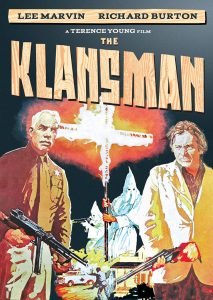 (1974, Rated R) Lee Marvin (Sheriff Bascomb), Richard Burton (Breck Stancill), Cameron Mitchell (Butt Cutt Cates), O. J. Simpson (Garth), Lola Falana (Loretta Sykes), David Huddleston (Mayor Hardy Riddle), Linda Evans (Nancy Poteet), Luciana Paluzzi (Trixie), David Ladd (Flagg). Music: Stu Gardner and Dale O. Warren. Screenplay: Millard Kaufmann and Samuel Fuller, based on the novel by William Bradford Huie. Director: Terrence Young. 112 minutes.
(1974, Rated R) Lee Marvin (Sheriff Bascomb), Richard Burton (Breck Stancill), Cameron Mitchell (Butt Cutt Cates), O. J. Simpson (Garth), Lola Falana (Loretta Sykes), David Huddleston (Mayor Hardy Riddle), Linda Evans (Nancy Poteet), Luciana Paluzzi (Trixie), David Ladd (Flagg). Music: Stu Gardner and Dale O. Warren. Screenplay: Millard Kaufmann and Samuel Fuller, based on the novel by William Bradford Huie. Director: Terrence Young. 112 minutes.
Tags: History, Drama, Terrible
Notable: A train wreck on and off the set; Italian actress Paluzzi wasn’t a good choice for a Southern girl.
Rating: ★★☆☆☆
In a small Alabama town, where the mayor is just another good ol’ boy Klansman, a sheriff has to balance presumably small acts of racial violence with keeping the peace in a powder-keg of personal and political tensions. Tempers flare when a black man is accused of raping a white woman, and an angry man resorts to vigilante justice. As outsiders arrive to cover the story of a civil rights rally, the KKK forms a lynching party, hell-bent on killing anyone — white or black — who gets in their way.
To a modern audience, this film will feel dated and melodramatic or (worse still) “racist.” (That is, rather, the point of the film.) The value of this work lies in its unflinching look at something real in the “deep South” of the 1960s, as well as the fact that some (perhaps many) aspects of this horrifying lens upon this area of the United States are still going on, whether surreptitiously or right out in the open. There’s still the Klan, still lynching, still Jim Crow laws, still blatantly unfair application of “justice,” and still more. To that degree, nothing at all has changed.
Beyond this sad reminder of how civilization has yet to reach that part of the United States after nearly half a century, the film has little to recommend it. The script is uneven at best, made worse by Fuller having written the version preferred by Executive Producer Bill Schiffrin, and Kaufmann writing (“distorting” –Schiffrin) the final draft. The director, Terrence Young, was known at the time for his work on the first three James Bond films, Dr. No, From Russia With Love, and Thunderball. (It was he who hired Luciana Paluzzi, villain Fiona Vulpe in Thunderball, to play a Southern girl named “Trixie”; it was Schiffrin who wanted Joanna Moore for the part, and the studio hired Moore to overdub Paluzzi’s lines.) There are sequences that feel as if they want to be somehow secretive, spy-like, but they come off more like bad conspiracy theories.
What mystifies most reviewers (e.g., Gene Siskel) is that “Lee Marvin and Richard Burton lent their talents to it” (20 Nov 74, Chicago Tribune). It probably didn’t help matters that Burton himself went through three quarts of whiskey per day, often drunk enough that most of his lines had to be delivered with him sitting or lying down, since he was unsteady on his feet. Some of his lines come out slurred, and even more, his gloriously refined Welsh-British accent occasionally fought for supremacy over the Southern accent his character is supposed to provide. According to some, the entire cast was going through difficult times in their personal and professional lives, and all were drinking heavily; even so, each arrived at the set on time, with their lines ready. (As a devoted Richard Burton fan, I was interested in this film to see why he had worked on it; my research says that it was the $40,000/week “plus points” [percentage of the profits] that did it. He was off the sauce and back on his game for films like Equus [1977] and The Medusa Touch [1978].)
It’s been said that films like In the Heat of the Night (1967) and …tick…tick…tick… (1970) are supposed to be films that covered the same literary territory better. I disagree forcefully, not because this film is of superior quality, but because this film is so in-your-face accurate of the horrors of the Deep South. The Poitier/Steiger film of 1967 is a crime drama with the powerful setting of interracial tensions in a small town, but it was not nearly as much a “tinderbox” as is so graphically shown here. Although I’ve not seen the 1970 Jim Brown film, it is widely viewed as “blaxploitation” (a film specifically made to try to attract black audiences with a leading black man and a plot showing the lead overcoming his adversaries, who are usually white), and even more, it shows a “change of heart” in the small town population, where they come to accept their new black sheriff. This film, although terrible for many reasons, paints a greater picture of the true “sound and fury” of the South of that time… and perhaps into the present.
